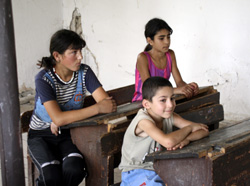
A Ruin That Resembles a School
I wanted to write “A School That Resembles A Ruin” but I think this is a more befitting title, because a school can end up looking like a ruin for a number of reasons – say, an earthquake, fire or flood – but I had never before seen a ruin that resembles a school.
I would not have thought that it was a school if not for the board on the wall bearing the sober heading “Discipline Rules for Students” or the rooms with furniture from the 1950's and –60's. I would have thought that it was just another ruin and passed by.
I am writing about the school in the village of Karmrakuch in the Hadrut region. Karmrakuch is very close to the city of Hadrut - just 3-4 kilometers away - and has 130 residents. Twelve children attend classes in the ruin that resembles a school. Karmrakuch was never occupied by Azeris during the war and thus the current state of the school is not a result of military operations.
 Principal Karine Davtyan said that according to stories she had heard from her elders, the school was built in 1928 for Saturday classes. That meant that there was never a plan or any fi nancial allocations. The villagers simply got together and built a school building, which ha s never been renovated since then. “We whitewash it every year before September 1, but that's all we do,” Davtyan said.
Principal Karine Davtyan said that according to stories she had heard from her elders, the school was built in 1928 for Saturday classes. That meant that there was never a plan or any fi nancial allocations. The villagers simply got together and built a school building, which ha s never been renovated since then. “We whitewash it every year before September 1, but that's all we do,” Davtyan said.
The neglected state of the school has a negative impact on the quality of education there. Parents who can afford to do so send their children to study at the Hadrut secondary school. Karine Davtyan regretted losing those students but understood their parents' concerns. “When there is a strong wind, we gather the children in the faculty lounge. The walls on the other side have cracks in them. Obviously, this half-collapsed school will negatively impact the children's education, their psyche, their everything.”
The village is not far from Hadrut and is linked through the final section of the North-South highway. Perhaps a better solution, rather than building a new school, would be to provide the children with the means for daily transportation. The school principal felt that that could be a relatively inexpensive solution, but that Karmrakuch would soon cease to exist. “If there is no school in the village then it's obvious that there won't be a village soon either. 12-13 students are not too few, from what I understand. We have five teachers – what should we do, become housewives and sit at home?”
 |
 |
The small student body is the reason why the school is always excluded from government programs. They say that there are more important things to do but never say when it will finally be Karmrakuch's turn. Because there are few students, there is perhaps no real need to build a new school.
“A school is the mirror and the soul of the village. If there is no school, what village is there to speak of?” asked Karine Davtyan, “There are 19-20 young people in the village now – boys who have served in the army and been discharged. Obviously, they want to get married, have children and start families. If there is not going to be a school, why should they stay in this village? This village feels like a retirement home.”
The bell at the Karmrakuch School will ring again this September and the school will probably celebrate 80 years of its founding two years from now. But perhaps on that occasion a new board will hang on its wall bearing the words “No children allowed”.
 Videos
Videos Photos
Photos




Write a comment